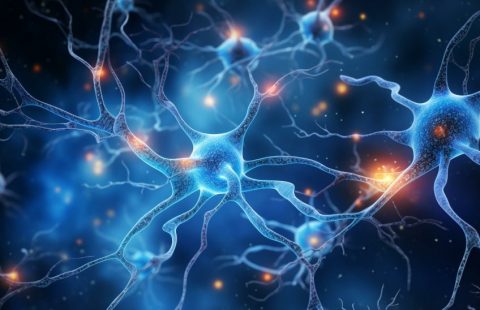 © AdobeStock
© AdobeStock
Because of their cyclical rhythm and similar durations, the menstrual and lunar cycles have often been assumed to be linked, despite no solid evidence so far to support this. To gain a better understanding of the origin of the rhythmic regularity of the menstrual cycle, an international research team involving Inserm, CNRS and Université Claude Bernard Lyon 1 compared a large amount of data on cycles collected from studies conducted in Europe and North America. Its findings show that the menstrual cycle is finely regulated by an internal clock, which in turn is occasionally influenced by the lunar cycle. This research, to be published in Science Advances, argues in favour of further study of this potential link, to identify the potential relevance of chronobiology in the treatment of fertility disorders.
The average length of a typical human ovarian cycle, or menstrual cycle, is 29.3 days, varying from one person to another and from one cycle to another within the same person. It begins on the first day of menstruation and consists of three phases, each dedicated to the realization of a specific process linked to ovulation, which occurs around Day 14 of the cycle.
Some studies have suggested that each phase may be influenced by an internal clock, the disruption of whose rhythm is associated with irregularities in the menstrual cycle.
In humans, the most well-known internal clock is the circadian clock, which is very close to 24 hours and maintains the sleep-wake cycle and the various physiological rhythms. It is synchronised with the day-night cycle under the influence of light. When the circadian clock is disrupted – such as with jet-lag – it takes a few days to return to its normal rhythm, resynchronising with the new day-night cycle.
In the case of menstrual cycles, the involvement of an internal clock could manifest in a similar way: the cycle length should be highly stable within individuals and, if disrupted, its optimal rhythm should be restored by mechanisms of adaptation through synchronisation with external conditions.
So what could this ‘external synchroniser’ be? One recurring theory suggests that the lunar cycle could play this role, but scientific evidence is lacking to date.
An international research team led by Claude Gronfier, Inserm researcher at the Lyon Neuroscience Research Centre (Inserm/CNRS/Université Claude Bernard Lyon 1), has investigated the potential existence of an internal biological clock that would regulate the menstrual cycle and which may be synchronised with the lunar cycle. Using a large database of menstrual cycles collected in European and North American studies, the team was able to compare a total of approximately 27,000 menstrual cycles in 2,303 European women and approximately 4,800 cycles in 721 North American women.
The researchers began by examining the stability from one menstrual cycle to another at an individual level, by comparing the lengths of successive cycles. They observed that the average length of each participant’s cycle was stable overall, even though out of a series of successive cycles some were longer or shorter than that person’s ‘standard’ cycle.
‘These observations suggest the existence of a mechanism that corrects the difference between the length of the current cycle and that of a typical menstrual cycle in the person concerned, explains René Écochard, first author of the study, a doctor at the Hospices Civils de Lyon and professor at Université Claude Bernard Lyon 1. A few shorter cycles could therefore compensate for a series of a few longer cycles so that the total length of the cycle is around the usual length of the menstrual cycle. The length of a cycle could therefore depend on the length of previous cycles.’
‘The observation of this phenomenon argues in favour of the existence of an internal clock that finely regulates menstrual cycles, itself synchronised by a cyclical environmental event,’ adds Gronfier.
Secondly, the research team looked at the potential relationships between the onset of menstruation in the cycles studied and the phases of the moon at the time the data was collected.
It was able to observe an occasional but significant association between the menstrual cycle and the lunar cycle with, however – and without this research being able to explain its cause – a major difference between the European cohorts and the North American cohort: in the European cohorts, the cycle began more often during the waxing phase of the moon, whereas in the North American cohort it began more often at full moon.
‘Despite this astonishing difference, which we are unable to explain at present, the links identified in this research between the lunar and menstrual cycles, through their proximity to certain phenomena that we observe in chronobiology, suggest that the periodicity of menstruation and ovulation could be influenced, in a modest but significant way, by the lunar cycle,’ adds Gronfier.
These findings therefore argue in favour of an internal clock system with a near-monthly rhythm, synchronised to a small extent by the lunar cycle. However, they need to be studied in more depth and confirmed by laboratory studies and larger epidemiological studies.
‘Thanks to smartphone apps for recording cycles, the emergence of large databases containing information on the cycles of several hundreds of thousands of women could provide new opportunities for studies,’ says Écochard.
‘Confirming the existence of an internal clock coordinating the menstrual cycle, as well as the mechanisms involved in its synchronisation, could make it possible to apply personalised “circadian” medicine approaches – which are already used in oncology and for the treatment of sleep disorders or depression, for example – to problems such as ovulation and fertility disorders,’ concludes Gronfier.
These contents could be interesting :


